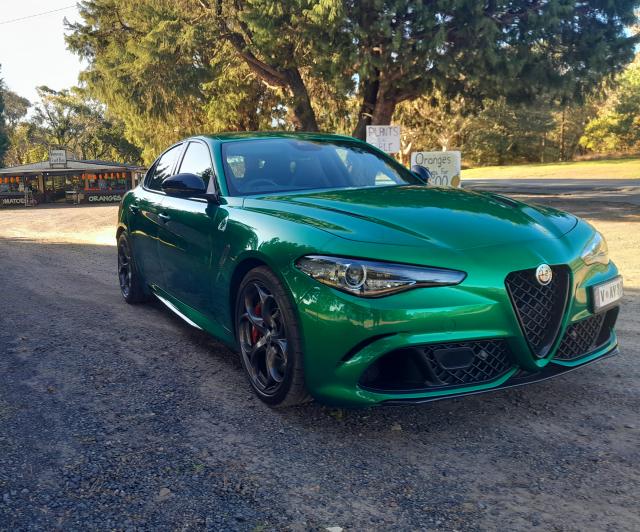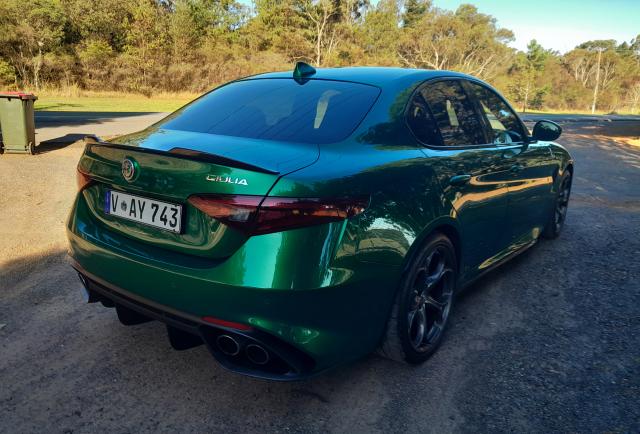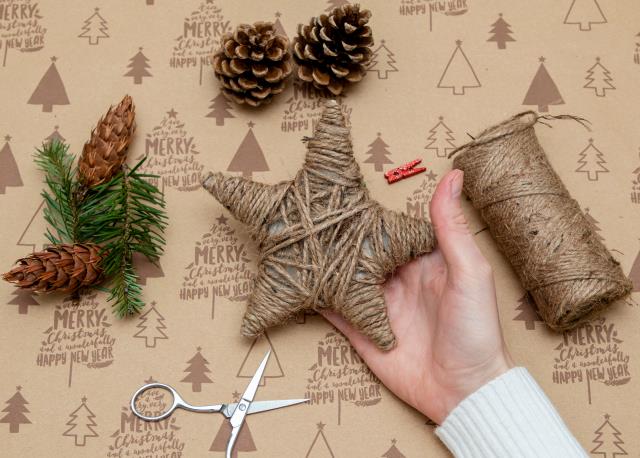Alfa Romeo Giulia is a stylish Italian sports sedan built on a rear-drive platform and designed to tackle the market segment currently dominated by the premium European brands.
Although the name Giulia (pronounced Julia) was around in the 1960s and early 1970s it didn’t re-emerge until 2015 when, to the delight of Alfistis everywhere, the company broke away from using the bland numeric names 156 and 159 and returned to such a distinctively Italian one.
There are five models in the Giulia range: Ti, Veloce, Quadrifoglio, GTA and GTAm.
There’s a huge difference in price, starting from around $70,000 for the Ti and Veloce, then doubling once to the $143,000 Quadrifoglio and doubling again to the track-ready GTA and GTAm.
Our test car was the Quadrifoglio, which is Italian for four-leaf clover and has been the symbol for Alfa racing cars for close to 100 years. In modern times Quadrifoglio, often abbreviated to QV, indicates high-performance road cars.
STYLING
Giulia Quadrifoglio is a real stunner. It’s very svelte and Italian in its shape and drew plenty of attention wherever we went due in no small part by the rich Montreal Green version that we tested.
Indeed, one Irish colleague was so smitten by the combination of the colour and the shamrock/clover badges (there is a difference apparently) on the sides that only my mention of the price tag stopped him from rushing off to buy one.
The exterior is highlighted by the traditional triangular shield grille flanked by two lower-mounted grilles in the apron. The bonnet has two cooling outlets for the engine bay
There’s a carbon-fibre splitter and large air intakes for the intercoolers as well as the brakes. The side skirts also feature carbon-fibre inserts and there are gill-style outlets either side at the front to allow air to escape from the wheel housings.
The “angry-eyes” headlights, narrow on the inside and swept-back over the front fenders, add to its striking appearance.
Unlike some of its competitors, there is no wagon variant for the Giulia although the recently-released Stelvio SUV Quadrifoglio is there if a more functional interior is needed.
INTERIOR
Giulia is built close to the ground making entry and exit difficult for less supple occupants. Consequently, the driving position is lower than we normally like but Giulia is a sports sedan so that’s to be expected.
The dashboard tilts slightly towards the driver.
Our test QV came with optional black leather with Alcantara inserts and green/white stitching. The front seats have tall rigid bolsters which will challenge ample-buttocked occupants but do provide excellent support.
Cabin storage is adequate, with dual cup holders and a sizeable smartphone-sized alcove at the base of the dashboard and an adjacent USB socket. There are two more USB ports in a small centre console storage box with a wireless phone charging pad next to them.
There’s also a useful small slot in the centre console to fit the keyfob.
The rear does have three seatbelts but the centre seat is not only narrow but it sits on top of a very high transmission tunnel that makes seating, even for children, all but impossible. Perhaps a child seat might just be squeezed in but not much else. Otherwise the fold down armrest, with twin cupholders, will be in place all the time.
On the plus-side the two useable rear seats are large and supportive as well as heated. As with the front seats they are finished in leather and Alcantara. Head and legroom are reasonable and there are twin air vents and a pair of USB ports.
Boot size is a decent 480 litres although access through the narrow opening can be a squeeze. The latest upgrade added a powered tailgate.
ENGINES / TRANSMISSIONS
Both the Ti and Veloce are powered by a 2.0-litre four-cylinder turbocharged engine with outputs of 206 kW and 400 Nm at 2250 rpm.
The 2.9-litre twin-turbo V6 in the Giulia Quadrifoglio Verde (QV) is something special with its Ferrari-inspired 500 horsepower (375 kW) twin-turbocharged engine. That peak power comes in at 6500 rpm with the redline set at 7000 revs. There’s an impressive 600 Nm all the way from 2500 to 5500 rpm.
All engines are mated to an eight-speed ZF automatic gearbox with large aluminium manual gearshift paddles.
SAFETY
Although the Quadrifoglio hasn’t been tested by ANCAP the lower spec Veloce achieved a five-star rating including an adult occupation protection rating of 98 per cent.
Standard safety features in the Giulia QV include six airbags, active cruise control, rear cross traffic alert, intelligent speed control, driver inattention alert, traffic sign recognition, automatic high beam system, lane departure warning and lane keep assist and, forward collision warning.
There’s also active blind spot assist, autonomous emergency braking, tyre pressure monitoring, reversing camera, front and rear parking sensors and rear-view mirror auto-dimming, and Isofix child seat anchors in the outer rear seats.
INFOTAINMENT
Display is through a small 8.8-inch touchscreen embedded in the top centre of the dashboard that can, and should be, operated by a new rotary dial on the centre console.
Traditionalists will be happy with the two large analogue instrument dials for the driver with a digital speedometer in between.
As is the norm nowadays there’s a lot of learning needed to operate what is quite a complex infotainment system including a triple split screen. As always, given that we only have most vehicles for a week, we try to avoid being too critical of features that owners will quickly adapt to.
There’s built-in satellite navigation, DAB+ digital radio, wireless Apple CarPlay but wired Android Auto as well as an impressive 14-speaker Harman/Kardon system called Sound Theatre.
DRIVING
As good as the Giulia Quadrifoglio looks it’s also a brilliant car to drive. It’s a true sports model, with an all-new rear-wheel drive architecture giving it 50:50 weight distribution. It’s the first Alfa sedan to be driven by its rear wheels since the early 1990s. Weight is kept down through the use of lightweight steel and composite materials such as carbon fibre.
Like an increasing number of new vehicles Giulia comes with a start/stop button, many of which are annoyingly tucked away out of sight behind the steering wheel. Determined to be different, the Alfa designers have cleverly positioned the button at the bottom of the steering wheel itself. At least it’s at the bottom once the driver gets into the habit of parking, as we all should, with the wheels pointing straight ahead.
Once pressed the fun starts with the 2.9-litre twin-turbo engine sending out a lovely V6 burble through the four tailpipes.
Around town the Giulia QV is a little awkward with ground clearance of just 100mm needing a fair bit of caution and angled approach around driveways and the like.
The Alfa DNA Driving Mode Selector offers four main drive modes: Advanced Efficiency (for poor traction conditions), Normal, Dynamic and Race. Each of these changes the settings for the dampers, torque limiter, steering, gear shifts, all-wheel drive system, exhaust valve, throttle sensitivity and torque vectoring.
Most drivers, as we did, will spend most of the time in Dynamic rather than Normal mode as it provided everything we required.
Extra-large piece aluminium paddle shifters are fixed to the steering column encouraging their use – just for the fun of it.
Fuel consumption is listed at 8.2 litres per 100 kilometres kept down by the combination of auto engine stop-start and cylinder deactivation which shutting down three of the six cylinders when not required. We averaged a touch over 10 L/100km during our test, still pretty good for such a sporty car.
SUMMING UP
Alfa Romeo Giulia QV is a car with the character that you expect from Italy in that combines stunning looks with outstanding performance.
Anyone who is in the market for a mid-sized sports sedan should forget all their pre-conceptions about Alfa and at least take it for a test drive before rushing in and buying one of its mostly German competitors.









